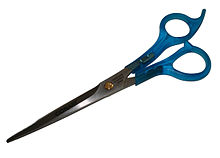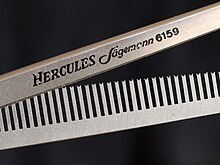Barber scissors
A barber scissors is a special hand shears , which in almost all professional hairdressers comes or hairdressers used. Hairdressing scissors and thus also the cutting edges are often made of rustproof or rustproof steel alloys. Hairdressing scissors cause significantly fewer split ends than normal household scissors.
Executions
In hairdressing scissors, and hair cutting scissors called, several factors must be considered: size and shape of the ground, with the blades of the scissors blades are provided, the material and the intended use. In addition to classic hairdressing scissors, a distinction is made between ordinary hairdressing scissors, thinning, modeling and slicing scissors. There are also so-called "hot scissors", which are primarily used for long hair. This is intended to seal the ends of the hair when cutting and thus prevent split ends. There are special left-hand scissors for left-handers.
Construction of the barber scissors
Hairdressing scissors consist of two scissor blades with cutting edges, the scissor lock or screw, two legs and two eyes. In addition, it can have a so-called finger hook on one eye, which is either an integral part of the eye or can be unscrewed. This finger hook makes it easier to handle and guide the scissors. The screw can be adjusted depending on the design of the scissors.
Cutting blades
The cutting blades of the hairdressing scissors can either be smooth or have micro-serration. The micro-serration is particularly suitable for precise cutting, as the hair is not pushed forward as with smooth blades. A smooth blade is again suitable for thinning or so-called slicing hair.
shape
The ergonomics of the scissors play a major role for the hairdresser. Therefore it should meet the individual needs of the user. I.e. On the one hand, that the size should fit, but also the shape.
Classic shape
With this shape, the legs and scissor blades are of the same length and shape. The eyes are centered on the thighs.
Ergonomic shape
Typically, one of the legs is often bent or kinked. This shape is characterized by the different lengths of the scissor legs. One is longer than the other, which means that the eyes are not on the same level. This shape is designed for sustained work, as it is geared towards the position of the hand, fingers and thumb. Particularly with this form, it should be noted that you need left or right hand scissors, depending on your preference.
Chiroform
In contrast to the classic shape, the eyes of the scissors are directed outwards.
Thinning scissors
Thinning scissors are scissors that are serrated on both sides. The cutting blades are notched alternately so as not to capture all of the hair. With thinning scissors, only the hair (usually a third) that is between the special teeth during the cut is captured. Cutting with these scissors causes a “thinning” of the hair, which is used to tease the hair.
Modeling scissors
Modeling scissors are serrated like thinning scissors, but only on one side. These scissors capture more hair than the thinning scissors.
Slicing scissors
Slicing scissors have a hollow grind , which means that the cutting edge remains sharp. In addition, they are usually finely polished several times and have a manual trigger, which means that they are many times sharper than "normal scissors".
Left hand scissors
Hair scissors especially for left-handers as thinning, modeling or slicing scissors.
literature
- Wolfgang Schmidt (Ed.): “Hairdressing knowledge. Understanding - combining - designing creatively. “Bildungsverlag EINS, 2007, ISBN 3-427-91374-0 .
- Margot Hülsken, Helmut Kortekamp, Bernhard Wiggenlinghoff: “Skin and hair. Hairdressing specialist. “Verlag Europa-Lehrmittel, 2003, ISBN 3-8085-6582-9 .
Web links
- Process for making hairdressing scissors patent-de.com
- The hairdressing scissors friseur-fragen.de


